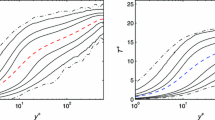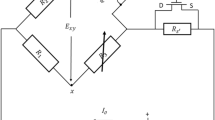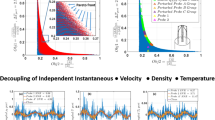Abstract
This paper reconsidered the criterion on the length-to-diameter ratio (l/d) of the hot-wire sensor, \(l/d \ge 200\), for end-conduction effects on the dynamic response of constant-temperature hot-wire anemometer (CTA) to be neglected. Experiments were first conducted using a low-noise compact CTA with hot-wire sensors of l/d = 80, 120, 150 and 200 in a two-dimensional (2-D) circular cylinder wake at a Reynolds number Re = 77, at which a 2-D von Kármán vortex street developed, allowing us to exclude spatial filtering and tangential velocity effects. The damping coefficient in the CTA bridge was tuned to 0.70 for all sensors to reduce possible influences of over- or under-damping on measurements in a frequency range up to 6 kHz. The stubs and prongs of probes consisted of identical materials and dimensions so that the thermal properties were considered to be identical for all probes. Careful comparisons of the amplitudes of the fundamental (1.9 kHz) and higher harmonic components of time-periodic wake vortices showed that the attenuation due to the end-conduction effect in the absence of the spatial filtering and damping coefficient effects was at most 2.5% in terms of the rms value of velocity fluctuations even for l/d = 80. The similar weak attenuation (about 2.6% for l/d = 80) was also observed in the measurements of low-frequency free-stream turbulence. In addition, effects of l/d on the yaw angle response of the sensor were examined in the free stream, revealing that the yaw angle (\(\psi \)) variation of the measured velocity (both the mean and fluctuations) obeyed the cosine law for \(\psi \le 60^\circ \). The Champagne constant k was 0.12 for l/d = 200 and 0.2 even for l/d = 80 in the mean velocity measurement using the present probe with long stubs. On the other hand, the intensity of free stream turbulence measured using a \(45^\circ \)-yawed sensor was significantly affected by the sensor’s l/d; the rms value of velocity fluctuation was attenuated by about 7.5% for l/d = 80.















Similar content being viewed by others
References
Ashok A, Bailey SCC, Hultmark M, Smits AJ (2012) Hot-wire spatial resolution effects in measurements of grid-generated turbulence. Exp. Fluids 53(6):1713–1722
Bailey SCC, Kunkel GJ, Hultmark M, Vallikivi M, Hill J, P, Mayer K. A., Tsay C., Arnold C. B., Smits A. J. (2010) Turbulence measurements using a nanoscale thermal anemometry probe. J. Fluid Mech. 663:160–179
Bruun HH (1995) Hot-wire anemometry. Oxford Sci. Pub, Oxford
Champagne F H, Sleicher C A, Wehrmann O H (1967) Turbulence measurements with inclined hot-wires Part 1. Heat transfer experiments with inclined hot-wire. J. Fluid Mech 28(1):153–175
Chin C, Hutchins N, Ooi A, Marusic I (2011) Spatial resolution correction for hot-wire anemometry in wall turbulence. Exp. Fluids 50(5):1443–1453
Comete-Bellot G, Strohl A, Alcaraz E (1971) On aerodynamic disturbances caused by single hot-wire probes. Trans. ASME, J. Appl. Mech 38(4):767–774
Fu MK, Fan Y, Hultmark M (2019) Design and validation of nanoscale cross-wire probe (X-NSTAP). Exp. Fluids 60(6):99
Hammache M, Gharib M (1989) A novel method to promote parallel vortex shedding in the wake of circular cylinders. Phys. Fluids A 1(10):1611–1614
Hultmark M, Ashok A, Smits AJ (2011) A new criterion for end-conduction effects in hot-wire anemometry. Meas. Sci. Tech. 22(5):055401
Hutchins N, Nickels TB, Marusic I, Chong MS (2009) Hot-wire spatial resolution issues in wall-bounded turbulence. J. Fluid Mech. 635:103–136
Hutchins N, Monty JP, Hultmark M, Smits AJ (2015) A direct measure of the frequency response of hot-wire anemometers: temporal resolution issues in wall-bounded turbulence. Exp. Fluids 56:18
Inasawa A, Takagi S, Asai M (2020) Improvement of signal-to-noise ratio of the constant-temperature hot-wire anemometer using transfer function. Meas. Sci. Tech. 31(5):055302
Johansson AV, Alfredsson PH (1983) Effects of imperfect spatial resolution on measurements of wall-bounded turbulent shear flows. J. Fluid Mech. 137:409–421
Klewicki JC, Falco RE (1990) On accurately measuring statics associated with small-scale structure in turbulent boundary layers using hot-wire probes. J. Fluid Mech. 219:119–142
Kűhn W, Dressler B (1985) Experimental investigation on the dynamic behaviour of hot-wire probes. J. Phys. E.: Sci. Instrum 18(7):614–622
Li JD (2004) Dynamic response of constant temperature hot-wire system in turbulence velocity measurements. Meas. Sci. Tech. 15(9):1835–1847
Ligrani PM, Bradshaw P (1987a) Subminiature hot wire sensors: development and use. J. Phys. E.: Sci. Instrum. 20(3):323–332
Ligrani PM, Bradshaw P (1987b) Spatial resolution and measurement of turbulence in the viscous sublayer using subminiature hot-wire probes. Exp. Fluids 5(6):407–417
Nishioka M, Sato H (1978) Mechanism of determination of the shedding frequency of vortices behind a cylinder at low Reynolds numbers. J. Fluid Mech. 89(1):49–60
Örlü R, Alfredsson PH (2010) On spatial resolution issues related to time-averaged quantities using hot-wire anemometry. Exp. Fluids 49(1):101–110
Perry AE (1982) Hot-wire anemometry. Clarendon Press, Oxford
Samie M, Hutchins N, Marusic I (2018a) Revisiting end conduction effects in constant temperature hot-wire anemometry. Exp. Fluids 59(9):133
Samie M, Marusic I, Hutchins N, Fu MK, Fan Y, Hultmark M, Smits AJ (2018b) Fully resolved measurements of turbulent boundary layer flows up to \(Re_\tau \)=20000. J. Fluid Mech. 851:391–415
Smits AJ, Monty J, Hultmark M, Bailey SCC, Hutchins N, Marusic I (2011) Spatial resolution correction for wall-bounded turbulence measurements. J. Fluid Mech. 676:41–53
Williamson CHK (1996) Vortex dynamics in the cylinder wake. Annu. Rev. Fluid Mech. 28:477–539
Acknowledgements
This work was partly supported by JSPS Grant-in-Aid for Scientific Research (Grant Number 17K18939).
Author information
Authors and Affiliations
Corresponding author
Additional information
Publisher's Note
Springer Nature remains neutral with regard to jurisdictional claims in published maps and institutional affiliations.
Rights and permissions
About this article
Cite this article
Inasawa, A., Takagi, S. & Asai, M. Experimental investigation of the effects of length-to-diameter ratio of hot-wire sensor on the dynamic response to velocity fluctuations. Exp Fluids 62, 92 (2021). https://doi.org/10.1007/s00348-020-03131-1
Received:
Revised:
Accepted:
Published:
DOI: https://doi.org/10.1007/s00348-020-03131-1




